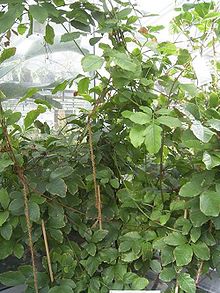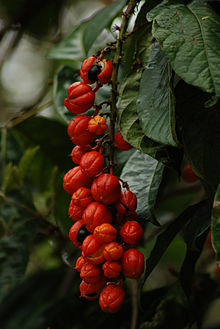Guarana
| Guarana | |
|---|---|

| |
| Scientific classification | |
| Kingdom: | Plantae |
| Clade: | Tracheophytes |
| Clade: | Angiosperms |
| Clade: | Eudicots |
| Clade: | Rosids |
| Order: | Sapindales |
| Family: | Sapindaceae |
| Genus: | Paullinia |
| Species: | P. cupana
|
| Binomial name | |
| Paullinia cupana | |
Guarana (/ɡwəˈrɑːnə/ from the Portuguese guaraná [ɡwaɾɐˈna]), Paullinia cupana, syns. P. crysan, P. sorbilis) is a climbing plant in the maple family, Sapindaceae, native to the Amazon basin and especially common in Brazil. Guarana has large leaves and clusters of flowers, and is best known for the seeds from its fruit, which are about the size of a coffee bean.
As a dietary supplement or herb, guarana seed is an effective stimulant:[1] it contains about twice the concentration of caffeine found in coffee seeds (about 2–4.5% caffeine in guarana seeds, compared to 1–2% for coffee seeds).[2] The additive has gained notoriety for being used in energy drinks. As with other plants producing caffeine, the high concentration of caffeine is a defensive toxin that repels herbivores from the berry and its seeds.[3]
The colour of the fruit ranges from brown to red and they contain black seeds that are partly covered by white arils. The colour contrast when the fruit is split open has been compared with the appearance of eyeballs, and has become the basis of an origin myth among the Sateré-Mawé people.[4]
History and culture

The word guarana comes from the Guaraní word guara-ná, which has its origins in the Sateré-Maué word for the plant, warana,[5] that in Tupi-Guarani means "fruit like the eyes of the people."
Guarana plays an important role in Tupi and Guaraní Paraguayan culture. According to a myth attributed to the Sateré-Maué tribe, guarana's domestication originated with a deity killing a beloved village child. To console the villagers, a more benevolent god plucked the left eye from the child and planted it in the forest, resulting in the wild variety of guarana. The god then plucked the right eye from the child and planted it in the village, giving rise to domesticated guarana.[6]
The Guaranís would make an herbal tea by shelling, washing and drying the seeds, followed by pounding them into a fine powder. The powder is kneaded into a dough and then shaped into cylinders. This product is known as guarana bread, which would be grated and then immersed into hot water along with sugar.[7]
This plant was introduced to European colonizers and to Europe in the 16th century by Felip Betendorf, Oviedo, Hernández, Cobo and other Spaniard chroniclers. By 1958, guarana was commercialized.[7][8]
Composition
| Chemical component | Parts per million |
|---|---|
| Adenine | |
| Ash | < 14,200 |
| Caffeine | 9,100–76,000 |
| Catechutannic-acid | |
| Choline | |
| D-catechin | |
| Fat | < 30,000 |
| Guanine | |
| Hypoxanthine | |
| Mucilage | |
| Protein | < 98,600 |
| Resin | < 70,000 |
| Saponin | |
| Starch | 50,000–60,000 |
| Tannin | 50,000–120,000 |
| Theobromine | 200–400 |
| Theophylline | 0–2,500 |
| Timbonine | |
| Xanthine |
The table contains a partial listing of some of the chemicals found in guarana seeds,[9][10] although other parts of the plant may contain them as well in varying quantities.
According to the Biological Magnetic Resonance Data Bank, guaranine (better known as caffeine) is found in guarana, and is identical to caffeine derived from other sources, like coffee, tea, and mate. Guaranine, theine, and mateine are all synonyms for caffeine when the definitions of those words include none of the properties and chemicals of their host plants except caffeine.[11] Natural sources of caffeine contain widely varying mixtures of xanthine alkaloids other than caffeine, including the cardiac stimulants theophylline and theobromine and other substances such as polyphenols, which can form insoluble complexes with caffeine.[12][13] The main natural phenols found in guarana are (+)-catechin and (-)-epicatechin.[14]
Uses


Safety
In the United States, guarana fruit powder and seed extract have not been determined for status as "generally recognized as safe" (GRAS) by the Food and Drug Administration, but rather are approved as food additives for flavor (but not non-flavor) uses.[15][16]
Guarana is used in sweetened or carbonated soft drinks and energy drinks, an ingredient of herbal teas or contained in dietary supplement capsules. Generally, South America obtains most of its caffeine from guarana.[17]
Beverages
Brazil, the third-largest consumer of soft drinks in the world,[18] produces several soft drink brands from guarana extract. Paraguay is also a producer of guarana soft drinks with several brands operating in its market. The word guaraná is widely used in Brazil and Paraguay as a reference to soft drinks containing guarana extract.
References
- ^ Johannes, Laura (March 2, 2010). "Can a Caffeine-Packed Plant Give a Boost?". The Wall Street Journal. p. D3.
- ^ Bempong DK, Houghton PJ, Steadman K (1993). "The xanthine content of guarana and its preparations". Int. J. Pharmacog. 31 (3): 175–81. doi:10.3109/13880209309082937. ISSN 0925-1618.
- ^ Ashihara H, Sano H, Crozier A (February 2008). "Caffeine and related purine alkaloids: biosynthesis, catabolism, function and genetic engineering". Phytochemistry. 69 (4): 841–56. doi:10.1016/j.phytochem.2007.10.029. PMID 18068204.
- ^ Prance G, Nesbitt M, eds. (2004). Cultural History of Plants. New York: Routledge. p. 179.
- ^ "guarana". Merriam Webster. Retrieved 2007-09-18.
- ^ Beck HT (2004). "10 Caffeine, Alcohol, and Sweeteners". In Ghillean Prance; Mark Nesbitt (eds.). Cultural History of Plants. New York: Routledge. p. 179. ISBN 978-0-415-92746-8.
- ^ a b Weinberg BA, Bealer BK (2001). The World of Caffeine: The Science and Culture of the World's Most Popular Drug. New York: Routledge. pp. 259–60. ISBN 978-0-415-92723-9.
- ^ Bennett Alan Weinberg and Bonnie K. Bealer (2001). The World of Caffeine: The Science and Culture of the World's Most Popular Drug. p. 260.
- ^ a b "Guarana", Dr. Duke's Phytochemical and Ethnobotanical Databases, 2007-09-18, OCLC 41920916, archived from the original on 2004-11-19, retrieved 2007-09-18
{{citation}}: Unknown parameter|deadurl=ignored (|url-status=suggested) (help) - ^ a b Duke JA (1992). Handbook of phytochemical constituents of GRAS herbs and other economic plants. Boca Raton: CRC Press. ISBN 978-0-8493-3672-0. OCLC 25874249.
- ^ "Caffeine". Biological Magnetic Resonance Data Bank, University of Wisconsin-Madison. Retrieved 2007-09-19.
- ^ Balentine D. A.; Harbowy M. E.; Graham H. N. (1998). "Tea: the Plant and its Manufacture; Chemistry and Consumption of the Beverage". In G Spiller (ed.). Caffeine. CRC Press. ISBN 978-0-8493-2647-9.
- ^ "Substance Name: Caffeine [USP:BAN:JAN]". ChemIDplus. US National Library of Medicine. Retrieved 28 January 2015.
- ^ Carlson M, Thompson RD (July–August 1998). "Liquid chromatographic determination of methylxanthines and catechins in herbal preparations containing guaraná". Journal of AOAC International. 81 (4): 691–701. PMID 9680692.
- ^ "FDA Responds to Durbin's Energy Drink Letter". Natural Products Insider, Global Health and Nutrition Network. 20 August 2012. Retrieved 21 February 2017.
- ^ "Guarana gum and guarana seed extract; Everything Added to Food in the United States (EAFUS); Documents 2189 and 3150". US Food and Drug Administration, Silver Spring, MD. 23 April 2013. Retrieved 21 February 2017.
- ^ Weinberg BA, Bealer BK (2001). The World of Caffeine: The Science and Culture of the World's Most Popular Drug. New York: Routledge. p. 230. ISBN 978-0-415-92723-9.
- ^ Weinberg BA, Bealer BK (2001). The World of Caffeine: The Science and Culture of the World's Most Popular Drug. New York: Routledge. pp. 192–3. ISBN 978-0-415-92723-9.
